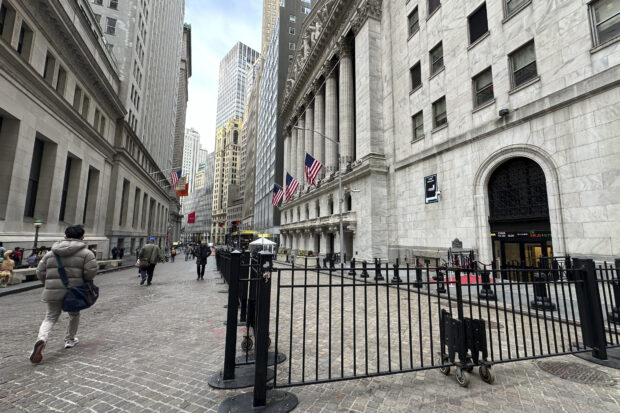Tumbling tech stocks drag Wall St to another losing week

People pass the New York Stock Exchange, right, on Wednesday, April 17, 2024 in New York. Global shares are trading mixed after most U.S. stocks slipped on firmer expectations that the Fed is committed to its current rate practices.(AP Photo/Peter Morgan)
NEW YORK — The worst week for big technology stocks since the COVID crash in 2020 dragged Wall Street on Friday across the finish line of another losing week.
The S&P 500 dropped 0.9 percent to close out its third straight losing week. That’s its longest such streak since September before it broke into a romp that sent it to a string of records this year.
The Nasdaq composite sank 2 percent. The Dow Jones Industrial Average, which has less emphasis on tech, was an outlier and rose 211 points, or 0.6 percent.
The market’s worst performers included several stocks that had been its biggest stars. Super Micro Computer lost more than a fifth of its value, dropping 23.1 percent. The company, which sells server and storage systems used in AI and other computing, had soared nearly 227 percent for the year coming into the day.
Nvidia, another stock that has surged to dizzying heights due to Wall Street’s frenzy around artificial intelligence technology, also gave up some of its recent gains. It slumped 10 percent and was the heaviest single weight on the S&P 500, by far, because of its huge size.
Tech stocks in the S&P 500 broadly lost 7.3 percent this week for their worst performance since March 2020 as some global giants reported discouraging trends. ASML, a Dutch company that’s a major supplier to the semiconductor industry, reported weaker-than-expected orders for the start of 2024, for example.
The larger threat was a dawning, dispiriting acknowledgment sweeping Wall Street that interest rates may likely stay high for longer.
READ: When will the US Fed cut rates? Maybe later or not at all
Top Fed officials said this week that they could hold interest rates at their high level for a while. That’s a letdown for traders after the Fed had signaled earlier that three cuts to interest rates could be possible this year.
Hotter-than-expected inflation
High rates hurt prices for all kinds of investments. Some of the hardest hit tend to be those seen as the most expensive and which make investors wait the longest for big growth, which can make tech stocks vulnerable.
Lower rates earlier appeared to be on the horizon after inflation cooled sharply last year. But a string of reports this year showing inflation has remained hotter than expected has raised worries about stalled progress.
Fed officials are adamant that they want to see additional proof inflation is heading down toward their 2 percent target before lowering the Fed’s main interest rate, which is at its highest level since 2001.
READ: US consumer inflation accelerated in March, dampening rate cut hopes
Traders are now largely forecasting just one or two cuts to rates this year, according to data from CME Group, down from expectations for six or more at the start of the year. They’re also betting on the possibility of no rate cut this year.
But Brian Jacobsen, chief economist at Annex Wealth Management, expects inflation to moderate as U.S. households that have become “hypersensitive to price hikes” by businesses begin slowing their spending.
“The giant sucking sound of optimism (escaping) from the market is due to the Fed’s lack of foresight and irrational focus on where inflation has been instead of where it’s going,” he said.
Because interest rates look unlikely to offer much help in the near term, companies are under even more pressure to deliver growth in profits. The recent drops in price have cooled a bit of the criticism that stocks had grown too expensive, but they won’t look cheap unless either prices fall further or profits jump higher.
Netflix slips despite stronger profits
Netflix sank 9.1 percent despite reporting stronger profits for the latest quarter than expected. Analysts called it a mostly solid performance, but the streaming giant disappointed some investors by saying it will stop giving updates on its subscriber numbers every three months, beginning next year.
READ: Netflix beats expectations on profit and subscribers
Helping to limit the market’s losses was American Express, which rose 6.2 percent. It reported stronger profit for the latest quarter than analysts expected. Fifth Third Bancorp rose 5.9 percent after it likewise topped expectations.
All told, the S&P 500 dropped 43.89 points to 4,967.23. It’s 5.5 percent below its record set late last month.
The Dow Jones Industrial Average rose 211.02 to 37,986.40, and the Nasdaq composite fell 319.49 to 15,282.01.
In the oil market, a barrel of Brent crude pulled back to $87.29 after briefly leaping above $90 overnight on worries about fighting in the Middle East. Iranian troops fired air defenses at a major air base and a nuclear site during an apparent Israeli drone attack, raising worries in the market. But crude prices pared their gains as traders questioned how Iran would respond.
READ: Japan’s Nikkei leads Asian market retreat as Middle East tensions flare
In the bond market, the yield on the 10-year Treasury eased to 4.62 percent from 4.64 percent late Thursday to trim its gain for the week. It had been down more overnight when worries were spiking about a potentially broadening war in the Middle East.
In markets abroad, stock indexes were mixed in Europe after falling more sharply in Asia.